Lecture
Это продолжение увлекательной статьи про история компьютерных игр.
...
computer and was forced to defrost the development of a computer created by the Atari team. Even then it was clear that the computer Atari loses the characteristics of the machine Amiga. Therefore, all forces have been thrown to ensure that the new Atari model went on sale before the Amiga computer. As a result, in June 1985 more than a month earlier than its main competitor, the Atari ST computer went on sale (or rather, the first model of the line - 520ST). The new Atari PC, like the Apple Macintosh 128K, was built on a 32-bit Motorola 68000 processor and had a mouse and graphical user interface with the user, but, unlike the Macintosh, it had 512KB of RAM, color graphics, a higher resolution image and an advanced sound system. MIDI compliant. And most importantly, the new Atari 520ST was significantly cheaper. If the Apple Macintosh 128K cost $ 2,500, then the new Atari, complete with a color monitor, could be purchased for a little less than one thousand dollars, and bundled with a monochrome monitor for only $ 799.99. Fast enough, the Atari ST line of computers was replenished with new models, both simpler and cheaper, and more expensive and advanced. As a result, computers of the ST series were well received and enjoyed success. Rich technical characteristics, and primarily color graphics, the ability to work with high resolutions and an advanced MIDI-compatible sound system, determined a fairly wide range of use of computers of the ST series. They were often used as office computers, inexpensive CAD / CAM systems, in computer layout systems. Often Atari ST was used by professional musicians as a MIDI controller in studio and concert work. And, of course, the ST series was often used as a home personal computer. For Atari ST computers, a large number of programs have been developed, including a large number of computer games. Until the end of the 80s (and even at the beginning of the 90s), the ST platform remained a popular gaming system with a large library of interesting game projects.
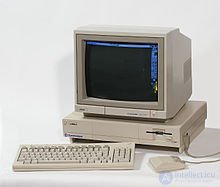
Amiga 1000
Atari ST was undoubtedly a very successful product, but as already mentioned, the creators were in a hurry with the release of this line of computers, since it was obvious that the new Atari computer was significantly inferior to the new computer created in the depths of Amiga Corporation. This became even more obvious when, on July 23, 1985, a new Amiga computer was introduced by Commodore International in Lincoln Center (New York, USA). The machine had characteristics unattainable for other desktop systems and is often called the world's first multimedia computer [57] [58] . The new personal computer was made in the spirit of other best modern machines: a graphical user interface, control with a mouse, color graphics. Nevertheless, a number of technologies were implemented in the computer, whose analogues appeared in competing solutions only after several years. So any Amiga computer was capable of hardware playback of 4-channel digital audio with an independent sampling rate of each channel. At the same time, by controlling the audio controller programmatically, it was possible to receive a 14-bit stereo audio stream. The video adapter contained a hardware graphics output accelerator, hardware displayed up to 8 multicolor sprites, produced hardware scrolling of the screen, had hardware display of system elements (for example, a mouse cursor), contained hardware blitter and could independently of the processor perform operations on filling and copying screen areas, as well as was able to hardware combine several screen buffers using the alpha channel. In addition, the graphics adapter itself was able to work with high-resolution graphics and display up to 64 custom colors (without taking into account the color sprites palette), and in the HAM mode up to 4096 real colors. The system contained a special memory controller with priority control with independent access of devices, chipset chips and a processor to shared memory. In addition, hardware I / O port processing was implemented. Also, for the first time, the architecture of automatic resource allocation was applied to the connected expansion devices. The AmigaOS operating system was very advanced for its time - the launch of all tasks took place in the preemptive multitasking mode. Such rich technical characteristics for several years markedly distinguished Amiga computers among other desktop systems. As a result, a large number of software developers paid attention to such a productive computer system, and a huge number of programs were released for Amiga. Amiga was often used to process sound, images, edit and process video. And undoubtedly computer games were very popular. Video games created for Amiga compare favorably with games for other gaming platforms. Often, developers created new games specifically for the Amiga, and later republished the game with some simplifications in graphics and sound for other platforms. For this platform, and a large number of exclusive games. Up until the mid-90s, the Amiga remained one of the most popular gaming personal computers in the world.
The game console market in Japan has fully recovered and by 1985 is the largest in the world. The truth in this market is almost completely dominated by Nintendo. At the same time, the company is attempting to enter the North American market (which until 1983 was the largest). To promote the console in the US market, Nintendo is in talks with Atari. However, Atari, dissatisfied with the relationship between Nintendo and Coleco (the fact of which, by the way, was never proven), breaks the relationship and concentrates on preparing to launch its own Atari 7800 console. After that, Nintendo tried to launch sales of the US Famicom console. The attempt was unsuccessful and the company decides to create a new version of the console specifically for the North American market. As a result, in June, the company introduced a new version of the console called the Nintendo Entertainment System. Trial sales of the updated console took place in New York and went very well. As a result, on October 18, official sales of the Nintendo Entertainment System started in New York, and the following year the release took place throughout the United States. Вскоре NES стала самой продаваемой игровой приставкой в США и оставалась такой до начала 90-х годов. Уровни продаж игровых приставок и игр к ним на территории США побили все рекорды, что позволило говорить о завершении кризиса индустрии в США. Сама же Nintendo Entertainment System до середины 90-х годов оставалась самой продаваемой игровой приставкой в мире [59] .
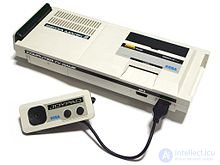
Sega Mark III
Очередную попытку войти на рынок игровых консолей предпринимает компания Sega. В октябре 1985 года на территории Японии начинаются продажи наследника приставок SG-1000 и SG-1000 II — новой игровой системы под названием Sega Mark III. Mark III стала абсолютно новой разработкой компании. При этом консоль по техническим характеристикам даже превосходила Nintendo Entertainment System. Большим плюсом новинки была возможность запуска игр от SG-1000 и SG-1000 II. Однако слабая поддержка игровой приставки со стороны производителей видеоигр и отсутствие игр с узнаваемыми названиями в очередной раз привело к неудаче. Слабые продажи Sega Mark III вынудили Sega остановить продажи игровой приставки и подготовиться к перезапуску в следующем году.
The developed market for computer games and the recovery of the game console market are attracting new video game developers. In 1985, many new companies were founded to develop and distribute gaming products. So it is worth mentioning the company Electric Dreams Software. Founded in 1985, the studio quickly established itself as a manufacturer of high-quality games for home computers and quickly became one of the eight largest gaming studios in the United Kingdom [60] . Electric Dreams Software existed until 1989 and during that time was remembered as a developer and publisher of many games, both original and created under licenses.
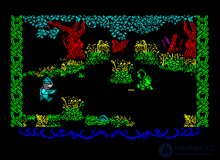
Robin of the wood
In the same year, the company Odin Computer Graphics, also specializes in the release of games for home computers. Their first release - the game Nodes of Yesod received positive reviews from critics and was successfully accepted by players. It is worth noting that the magazine Your Sinclair put the game on the 30th place in the list of the 50 best games of all time [61] . In the same year, Odin Computer Graphics released the continuation of this platform - the game Arc of Yesod, which was also greeted positively and enjoyed a well-deserved success. In the same year, the company pleased the players with another game. The labyrinth arcade game Robin of the Wood has also entered the ranks of the best-selling games on 8-bit computers. It is worth noting that Odin Computer Graphics existed even less than Electric Dreams and was dissolved in 1986. During its short existence, the company also managed to release another hit - the game Heartland. Despite the short life of the studio, the games produced by it were very recognizable. Odin Computer Graphics games have always stood out for vivid, memorable graphic design and musical accompaniment, as well as high-quality, well-developed character animation, which is rarely found on 8-bit gaming systems.
Also worth mentioning is the French company Titus Interactive, created this year, a developer and publisher of games for personal computers and game consoles. The company gained fame with the games Titus the Fox, The Blues Brothers and Metal Rage, as well as the successful series of games Crazy Cars, Fire and Forget and Prehistorik (including the very popular Prehistorik 2). Over time, Titus Interactive swallowed companies such as Digital Integration and BlueSky Software, as well as acquired the American gaming corporations Interplay Entertainment and Virgin Interactive. Thus, when in 2005 the company was declared bankrupt, it was one of the largest market players.
1985 was the year when Westwood Studios was founded (at first, Westwood Associates). Based in Las Vegas, the company has released a large number of famous games, had a great influence on the development of genres of role-playing games, quests and real-time strategies. The studio is listed in the Guinness Book of Records as the creator of one of the most successful games (the 1995 game Command & Conquer sold over 10 million copies). Initially, Westwood did not produce independent projects, but carried out orders from third-party companies for porting games from 8-bit systems to the Commodore Amiga, Atari ST and IBM PC platforms. The quality of the work involved attracted major publishers who began to provide Westwood with orders to create games under major licenses and games of famous game series. So the studio is involved in the release of some games of the series BattleTech, Dungeons & Dragons, A Nightmare On Elm Street (1989), The Lion King, Monopoly, Blade Runner. But the company's special success was brought to the company’s own development projects: the game Nox, the games of the Eye of the Beholder series, the Lands of Lore trilogies and The Legend of Kyrandia, as well as, of course, the games that made a breakthrough in the real-time strategy genre of the Dune and Command & Conquer games. In 1992, the studio was merged with Virgin Interactive, and in 1998 it became part of Electronic Arts, where it was one of the studios of the parent company until its closure in 2003.
Despite the fact that by 1985, the focus of video games had shifted to the home sector and home gaming consoles and personal computers had become the main means of interactive entertainment, although the sector of arcade gaming machines had shrunk, but still quite large. True, many companies adjust their business. There is a departure from slot machines with vector screens in favor of raster ones. This year there was only one game for a vector slot machine that became popular. She was Star Wars: The Empire Strikes Back, while the main part of the popularity of the game gave the famous franchise, and the remaining popular slot machine in 1983. The rest noted that the game is not original and does not introduce any new sensations to the gameplay. To increase the spread of the Atari game, even had to offer the game as a hardware update of the old arcade machine of 1983, but in this case many gaming shops ignored this possibility, having small but stable fees from the classic Star Wars machine. Almost all other vectorial automata of this year were commercially unsuccessful. Universal arcade machines instead of specialized ones are becoming increasingly popular. Many companies that do not have a universal arcade platform release their solutions this year. The Konami company releases its first universal devices, the Konami GX400 and a very specific, using the magnetoelectronic memory Bubble Memory, the Konami Bubble System. SNK also produces two universal arcade machines SNK Hall 21 and SNK Triple Z80. Sega updates the hardware of the existing arcade machines with the release of the Sega System 2 and Sega System E models, and also introduces a new 16-bit machine, the Sega Sysyem 16. Nintendo's gaming machines stand out a few, which introduced two universal Nintendo VS machines. UniSystem and Nintendo VS. DualSystem. Both systems are basically built on the hardware of the Nintendo Entertainment System game console.
Games created for universal systems are no less successful than games for which special gaming machines have been developed. For example, Atari for the Atari System 1 universal machine released a year earlier is releasing a game based on the recently released new film about the adventures of Indiana Jones and the Temple of Doom, the famous Indiana Jones archaeologist. The game did not stand out with any unique technical solutions, but was very well implemented: it had good graphics, digital sound (including digitized recognizable phrases from the original film) and as music the neatly arranged musical themes of John Williams. A well-made video game in a familiar setting is in high demand and becoming one of the most popular games of the year [62] . The high popularity of the arcade determines its future and Indiana Jones and the Temple of Doom will soon be released on almost all popular home gaming platforms: Amstrad CPC, MSX, ZX Spectrum, Commodore 64 (interestingly, for Commodore 64 there were two versions of the game from different manufacturers ), Atari ST, Commodore Amiga, IBM PC and, finally, Nintendo Entertainment System.
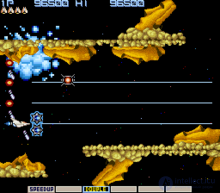
Gradius
For the recently released universal apparatuses, Konami is launching the game Gradius. The space horizontal scrolling jumble was shared by the original development system of the main character (the spacecraft) and quickly gained popularity, becoming one of the most popular games of the year, first in Japan and a little later in other parts of the world. Critics also favored the game, and the development system implemented in Gradius for many years to come became a benchmark for shooters [63] . According to many publications, the game is the greatest classic scrolling shooter [64] . The game has traditionally been re-released on most home gaming systems. Gradius was the first game of a large series of games, which has more than 20 original scrolling shooters.
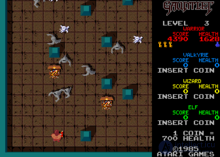
Gauntlet
Nevertheless, specialized arcade machines continue to appear. The same Atari this year produces a gaming machine Gauntlet. The game has become the first multiplayer gaming machine that allows up to four players to simultaneously participate in the game. To implement this feature, Atari has developed a special hardware platform [65] . In this case, the main feature of the game was a developed game mechanics - each player could choose one of four game characters, each of which has unique characteristics. Thus, players are given the opportunity not only to jointly play the game, but also to work together, complementing each other’s capabilities. Well-developed gameplay, high-quality graphics and sound design, successful fantasy setting predetermined the phenomenal success of Gauntlet. Popular and numerous ports for home gaming systems. Gauntlet versions for Commodore Amiga, Atari ST and Sega Genesis were made as close as possible to the original and also allowed up to four players to participate in the game, while versions for other systems were created with substantial simplifications. Nevertheless, the release of this game on all gaming platforms was accompanied by high popularity and successful sales.
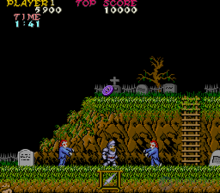
Ghosts' n goblins
For the game Ghosts' n Goblins, released in 1985, Capcom also developed its own hardware [66] . Despite the fact that Ghosts' n Goblins is a common platformer game has become very popular and is considered a classic. The popularity of the game was the reason for the creation of several sequels and spin-offs. Also, the games of this series were released for almost all popular home gaming systems, where they always turned out to be among the best-sellers. Nevertheless, many analysts have noted the excessively high complexity of the game. The game is very difficult by the standards of arcade machines and it is often noted that this fact has become an obstacle to an even greater increase in the popularity of the game. Many publications have included the game in the number of the most difficult computer games of the ever created [67] . However, the game still has a large number of fans, and the re-release of the games of the series on modern platforms is accompanied by success.
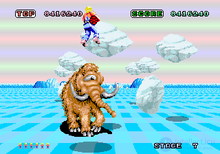
Space harrier
Sega launches new Space Harrier arcade machine. The game is an early third-person three-dimensional shooter. Space Harrier used proprietary technology Sega Super Scaler for hardware scaling of sprites and translucent shadows to display pseudo-three-dimensional objects. Especially for this machine was created a new hardware platform known as Sega Space Harrier Hardware [68] . The machine was distinguished by outstanding technical characteristics - the Sega Super Scaler technology allowed displaying on the screen up to 128 hardware-scalable sprites, a separate layer for displaying images in perspective (to form the surface of the earth) and separate layers for displaying raster and text data. At the same time, Space Harrier became one of the first slot machines displaying 16-bit graphics. The arcade became one of the most popular games of the year [69] and had a serious impact on the development of both the genre and the development of gaming platforms. The popularity of the game provoked the release of versions for home gaming consoles and computers, and also received a continuation with the release of Space Harrier 3-D, Space Harrier II and Planet Harriers games. The hardware platform Sega Space Harrier Hardware did not become a universal gaming machine, but nevertheless it was used by Sega in a few more specialized arcade devices. One of them, Hang-On, was also released in 1985 and became one of the best-selling slot machines of the year [70] . The use of proprietary technology Sega Super Scaler allowed to accurately convey the atmosphere of racing. The gaming machine cabinet was often produced as a real motorcycle, where a screen was installed instead of a windshield. The game was very popular with players, and was later ported to home gaming systems. Over time, several games have been released to continue the Hang-On series, including the very popular Super Hang-On and Limited Edition Hang-On.
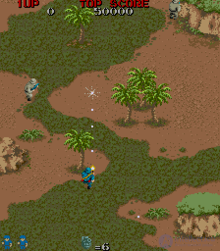
Commando
Capcom launches the Commando slot machine. To create a new vertical scrolling shooter Capcom has developed a new hardware arcade machine [71] . The game was originally released in Japan under the name Senjō no Ōkami (戦 場 の 狼, which translates from Japanese roughly as “Wolf to the battlefield” ), and was later introduced to the North American and European markets under the name Commando. Military shooter was very popular, but even more popular for the game came after the release of the game on personal gaming systems. Commando was released for a huge number of personal computers and game consoles, where it enjoyed even greater success. The game was seen by users of Commodore 64, Amstrad CPC, MSX, ZX Spectrum, Intellivision, Atari 2600, Atari 7800, Amiga, Nintendo Entertainment System, Acorn Electron, BBC Micro and IBM PC. It is interesting that the game was ported including some second-generation game consoles, which, for example, for the Atari 2600 was undoubtedly a significant moment. It is clear that the Atari game console once sold a huge circulation and naturally possessed one of the largest groups of players, however, released in 1977, at the dawn of the use of microprocessors, had very modest technical characteristics. Nevertheless, the authors of the port on the Atari 2600 managed, albeit in a very simplified form, to create a very recognizable analogue of the original game, which can undoubtedly be considered an achievement within the framework of a rather serious limitation of the technical capabilities of the platform. Commando had a major impact on the vertical scrolling shooter genre. There was a subgenre scrolling shooter of hostilities. Quite quickly, games appeared that copied the gameplay of the Commando, often called Commando-clones [72] . There were also very successful games copying the gameplay Commando. Among the most successful are the famous Who Dares Wins II (1985), Ikari Warriors (1986), Guerrilla War (1987), Frontline. Commando has undoubtedly become a notable game in the industry and is today considered a classic of the genre.
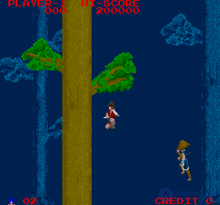
The Legend of Kage
Taito has released an arcade machine action-platform game on a fairly simple 8-bit platform, The Legend of Kage. The game did not differ special originality, nevertheless enjoyed relative popularity. This great popularity came to the game with the release of it on home gaming systems. The Legend of Kage is released on Amstrad CPC, Commodore 64, MSX, Nintendo Entertainment System, Sharp X1 and ZX Spectrum computers (and game consoles). It is on home gaming platforms that the game has become a recognizable classic. Versions of the game are found on modern platforms. Taito has released an updated version of the game in the Taito Legends Power Up collection on the PlayStation Portable game console, and in 2008 a full-fledged sequel to the game The Legend of Kage 2 for Nintendo DS was released.
The release of The Legend of Kage fell at the peak of the world popularity of martial arts, and Konami released its arcade machine Kun Fu theme. Yie Ar Kung-Fu is more of a fighting game with a fairly large number of developed tricks that a player can perform. Although the game was influenced by the Beat 'em up games of that time, the graphics in the game are deliberately "cartoonish", the animation of most movements is greatly simplified, and some elements are quite conditional (for example, the use of melee weapons). However, the game was very successful and was popular, and also had some influence on the development of the genre. The game had one game mode - player-against-computer, but in Yie Ar Kung-Fu each level is a battle with a unique opponent with its own unique features and combat style. The game was also seen by players of many 8-bit gaming systems, including NES, MSX, Commodore 64, ZX Spectrum, Amstrad CPC and Acorn Electron. In many countries, Yie Ar Kung-Fu became popular on home gaming systems, and the game itself was among the bestsellers [73] .
Konami was also marked this year by the release of the popular Rush'n Attack slot machine (also known in Europe and Japan as the Green Beret). Beating the popular theme of the Cold War, this action-platformer enjoyed good popularity in gaming parlors. But the real popularity came to the game when Imagine Software bought a license from Konami to create and release games on 8-bit home computers. As a result, Rush'n Attack saw the owners of the ZX Spectrum, Commodore Plus / 4, Commodore 64, Amstrad CPC, 8-bit Atari computers, MSX and BBC Micro. Subsequently, the version with this game moved to game consoles and primarily to the popular Nintendo Entertainment System. Today the game is considered to be a classic and is often reprinted for modern gaming systems [74] [75] .
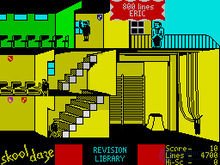
Skool daze
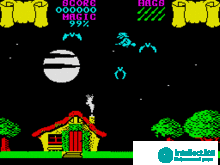
Cauldron (ZX Spectrum)
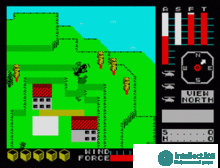
Cyclone
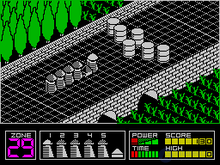
Highway Encounter
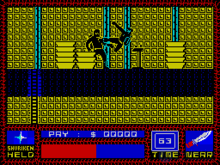
Saboteur!
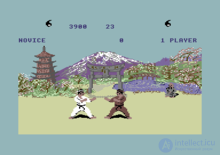
The way of the exploding fist
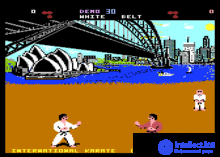
International karate
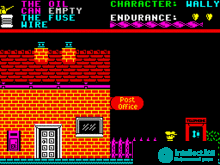
Everyone's a wally
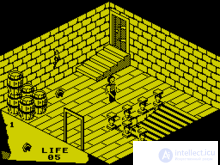
Fairlight
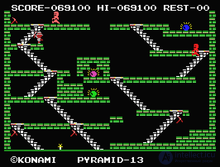
King's valley
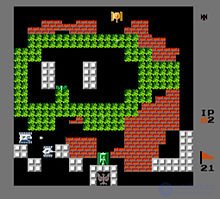
Battle city
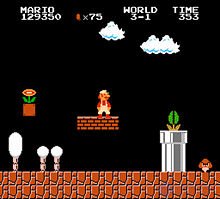
Super Mario Bros.
The bulk of the games this year was released for home computers. Thus, the success of games based on Filmation technology released in 1984 under the Ultimate Play The Game brand gave reason to release in 1985 the game Alien 8 using the same technology. Like its predecessor, the famous Knight Lore, the game Alien 8 was also originally released for the ZX Spectrum platform, and later transferred to the computers of BBC Micro, Amstrad CPC and MSX. The game, although it did not repeat the success of Knight Lore, nevertheless proved to be very successful and was popular on all gaming platforms. In the same year, the game engine itself was redesigned and called Filmation II. The main innovation of the technology was the large space of the game world (instead of limited rooms in the first version) and full-screen scrolling. In the same year, the first game on this technology was released - Nightshade. The use of the updated technology and the high quality of the project was highly praised by critics [76] and well received by the players. This game was originally released for the ZX Spectrum and later successfully re-released for the BBC Micro, Amstrad CPC, MSX and Commodore 64 platforms. It is significant that, since this game, Ultimate Play The Game has become increasingly oriented towards the wider market of games for Commodore 64.
This year Microsphere releases a very original game for the ZX Spectrum, Skool Daze, and in the same year a sequel - the game Back to Skool. The games were met with great enthusiasm by critics and received very positive reviews for unbanal gameplay. Both games enjoyed great success with the players. Each of the games have been repeatedly awarded and included in the number of the best games for the platform ZX Spectrum [77] [78] .
It should be noted the release this year by Activision of the original game Little Computer People. Without a genre orientation, the game was positioned by the manufacturer as House-on-a-Disk ( English house on disk), in fact, the player watched the life of the computer character and interacted with it interactively - giving simple commands, playing games with it. On the other hand, the character eventually began to initiate communication with the player himself. In fact, Little Computer People was nothing more than the first game that formed the life simulator genre. The game was very popular and was released for almost all popular computers of the time. Little Computer People has received many rave reviews from critics and awards. The gold medal of ZZap64 [79] and the Golden Joystick Awards for the best original game of the year [80] are proof of this. In addition, the game became the predecessor of Tamagotchi, Princess Maker and, finally, The Sims. Moreover, the creator of Little Computer People Rich Gold advised Will Wright when he created The Sims [81] .
Palace Software was marked by the release of action-adventure-platformer Cauldron. The game was released immediately for three gaming platforms ZX Spectrum, Amstrad CPC and Commodore 64 and received rave reviews from critics [82] [83] , who noted the high-quality design, good project graphics and fascinating gameplay. Good reviews in conjunction with the competent distribution of the game gave high sales. Cauldron enjoyed well-deserved popularity among players, and Palace Software a year later released a sequel called Cauldron II: The Pumpkin Strikes Back, also very successful.
Vortex Software marked the release of a new original game Costa Panayi (Costa Panayi) Cyclone. The game was released exclusively for the ZX Spectrum and used the same engine and similar ideas as the previous game Costa Tornado Low Level. True, the gameplay was built around a helicopter (unlike the aircraft in the previous game), which, according to journalists, made the game less dynamic, but the player’s actions have now become more thoughtful. Cyclone enjoyed no less success than its predecessor and became one of the most popular games. Some observers put the game on a par with classic computer avio-arcades, along with Combat Lynx and River Raid [84] . In the same year, Costa Panaia developed another game, which was also published by Vortex Software. We are talking about another original conceptual game Highway Encounter. The action puzzle game in the original setting with high-quality isometric graphics appealed to the players and became another bestseller. Critics were in solidarity with the players, calling the game the best of the Vortex Software games and giving Highway Encounter very high marks [85] [86] [87] . The popularity of the game has outgrown the native platform and was soon released for Amstrad CPC, Commodore 64 and MSX computers, where it was also a success. Highway Encounter ranks among the best games for the ZX Spectrum platform and is included in the CRASH Top 100 and Your Sinclair Top 100 lists.
Platform ZX Spectrum replenished this year with another interesting exclusive project. Games Workshop released the game Chaos: The Battle of Wizards (also known as Chaos) by Julian Gollop. Turn-based tactical game was developed under the impression of the Games Workshop Warlock board game and was originally supposed to be another card game, but eventually turned into a computer game. The original gameplay of the battle of wizards was received by interesting observers, who noted that the game has both non-standard and fascinating gameplay and gave the game quite high marks [88] . However, the popularity of Chaos among the players themselves was much higher than expected by the most optimistic critics. The game was a success for a long time, which gave rise to the release of the second part of the game under the name of Lords of Chaos. Moreover, the readers of the magazine Your Sinclair in the list of the top 100 computer games of all time put the game in fifth place [22] .
Lucasfilm Games loudly announced themselves last year with original game projects Rescue on Fractalus! and Ballblazer continued to delight fans of new games. Designed for Rescue on Fractalus! The technology of graphical construction of objects based on fractals has been improved and used in two new games, Koronis Rift and The Eidolon. The two Atari and Commodore 64 home computers were used as a target platform. True, the geography of the games presence was expanded and both games were released on the ZX Spectrum, MSX and Amstrad CPC platforms. Koronis Rift was generally well received by critics for the graphic performance and soundtrack; nevertheless, they noted a very weak gaming component of the game and, despite all the merits of the project, many called Koronis Rift simply boring [89] . The players Koronis Rift enjoyed relative popularity, but neither enthusiastic reviews nor sales records she could not boast. From this point of view, The Eidolon game has received much wider recognition. The creators of the game to create a three-dimensional environment used the original technique. The technology of forming three-dimensional objects on the basis of the fractal model was used to create not external, but internal surfaces. As a result, the game space moved into the caves and looked very impressive. And if the players accepted the game as a whole well, then the opinions of critics about The Eidolon diverged dramatically. If some said that Lucasfilm Games released their best game and undisputed masterpiece [90] , awarding the game a high rating and gold medals, others very coldly met the novelty and gave Eidolon the title of the worst game of the year [91] .
The Tau Ceti game released this year for the ZX Spectrum by CRL also featured a large three-dimensional game world. The game takes place on a small planet, the entire surface of which is a playground. At the same time, Tau Ceti stood out in an original way of displaying 3D graphics with solid surfaces with a shadow effect. The same technology allowed realistically display the change of time of day. These features were unique to the game and favorably distinguished it from the crowd. But the main thing is that the gameplay turned out to be fascinating. Reviewers positively rated Tau Ceti, awarding it with rave reviews [92] , and some even compared the game with the classic Elite [93] . Tau Ceti was very popular among players. The game was ported to other gaming systems and soon appeared on the Amstrad CPC, Atari ST, Commodore 64 and MS DOS. A year later, the sequel to the game Tau Ceti called Academy was released.
Also, the owners of ZX Spectrum this year received a wonderful action Saboteur! from the company Durell. Clive Townsend's spy thriller (Clive Townsend) has gained worldwide popularity, has received rave reviews from critics and the recognition of players. The game soon reached the Amstrad CPC, Commodore 64 and Commodore Plus / 4 gaming platforms, where it also became a bestseller. And in 1987, the story of ninja spies was continued with the release of the game Saboteur II: Avenging Angel, which deserved even greater distribution and popularity. However, the original Saboteur! Immediately after the release, he was named one of the best releases of this year [94] , and, to date, takes an honorable 55th place in the list of the 100 best games of all times at the version of Your Sinclair magazine.
RPG genre was developed with the release of the game from Interplay Productions for the Apple II platform called The Bard's Tale. The fantasy setting in general used the classic rules of Dungeons and Dragons. Nevertheless, for the first time for the genre a first-person view and a three-dimensional representation of the game world were used. Just for the first time, the portraits of the characters became animated. In addition to the technical performance, some original ideas were introduced into the gameplay. So the game character Bard had the original ability to cast spells while performing one of the melodies. For a number of innovations, The Bard's Tale received fairly high marks from critics [95] [96] . The game was so popular with users that it was soon transferred to other home gaming platforms, and, created for an Apple II 8-bit computer, the game was not only transferred to other 8-bit computers (Commodore 64, ZX Spectrum, Amstrad CPC, NEC PC-9801), but also on the console of the Nintendo Entertainment System, as well as on 16/32-bit computers Apple IIgs, Commodore Amiga, Atari ST, MS-DOS and Apple Macintosh. Later, the sequels of the game The Bard's Tale II: The Destiny Knight and The Bard's Tale III: Thief of Fate were released, each of which was also very popular.
Richard Garriot made a significant contribution to the development of the genre by releasing another game of the Ultima universe. Ultima IV: Quest of the Avatar is the first game in the New Age of Enlightenment trilogy. Starting with this game, the geography of the game world finally took shape. Ultime IV is the first to introduce the virtue system, which became the basis of the plot lines of all subsequent games in the series. The game is unique among all the other games in the series in that there is no main enemy in it, victory over which is the goal of the game. Undoubtedly, new trends influenced the development of the entire RPG genre and became not only one of the most significant games of the series, but also one of the most popular games [11] , and Computer Gaming World magazine put the game in second place in the list of the best games of all time [97 ] .
The increased popularity of Beat 'em up games has moved to a new, more serious level. The developers have paid attention to more technical genre of fighting games. So Melbourne House has released a new game developed by the studio Beam Software called The Way of the Exploding Fist. Originally created for the Commodore 64 computers, the game surprised many with a high level of development of combat techniques and character movements. A standard joystick could make up to 18 different tricks and movements of the player. High-quality graphics and sound, as well as the ability to play both together and in single player mode against the computer has made the game very popular. The game was a great success and was soon ported to the computers of the Amstrad CPC, ZX Spectrum, BBC Micro, Acorn Electron and Commodore 16. The Way of the Exploding Fist became the best-selling game of the month [98] , and critics gave the game very high marks [99] [ 100] [101] . The Way of the Exploding Fist received the Golden Joystick Awards in the category of the game of the year, and the publisher of Melbourne House was awarded the title of Best Software House [102] . The game was the beginning of a successful series of games, which soon added to the games Fist 2: The Legend Continues and Exploding Fist +.
By the end of the same year, System 3 released another very popular International Karate fighting game. In order to release the game simultaneously on several leading gaming platforms, several independent teams worked on creating the game. As a result, the first team released the game in November 1985 for the ZX Spectrum. The versions of the game for Commodore 64 and 8-bit Atari computers came out in a few months in 1986. Since the teams were independent, it is interesting that, despite the similar concept of the game, the versions for different computers have completely different graphics, animation and musical accompaniment. Based on these products, versions for other popular gaming systems were soon created: Amstrad CPC, Apple II, Atari ST, Commodore 16, MS-DOS, MSX. The game was also among the bestsellers, and many critics praised the new game and called it “as good as The Way of the Exploding Fist” [103] . But the game has left another bright mark in history. Like The Way of the Exploding Fist, International Karate was influenced by the 1984 Data East arcade machine by the Karate Champ. Such succession at that time was often used in the video game market, and even helped the development of computer games. But when the company Epx decided to release International Karate to the US market under a new name - the World Karate Championship [104] , Data East filed a lawsuit against the publisher. The essence of the claims was in borrowing ideas from the Data East game in view of the great similarity of the World Karate Championship and Karate Champ games. At the same time, it was indicated that the gameplay, and absolutely the same scoring system, and even the same colors of the kimono players were borrowed. In addition, special attention was paid to the fact that the names of the World Karate Championship and Karate Champ games have a striking similarity. The trial series took a long time. Decisions were made in favor of one or the other. The final decision was made only in November 1988 and removed from the Epyx guilt in copyright infringement. The statement said that the games are similar, but not identical [105] . This trial had a very serious impact on the development of the entire gaming industry, created a precedent and outlined a formal framework limiting the degree of borrowing ideas in video games [106] . This decision was one of the points of the legal acts on the protection of copyright of software developers.
Adventure genre is replenished with several interesting projects. Subgenre Action-adventure, which gained widespread popularity on home computers last year, continued to develop it. Mikro-Gen continued the Wally Week series of games with the release of Everyone's Wally and Herbert's Dummy Run for the ZX Spectrum, Amstrad CPC and Commodore 64. Both games, like their predecessor, Pajamarama, were very popular among the players and were praised by critics [107] [108] who, noting some shortcomings, still recommended games for mandatory purchase to all fans of the genre.
On the ZX Spectrum platform, Edge Games is launching the Fairlight Action-adventure game. The game compares favorably with other games of the genre by its visual design. Especially for Fairlight, a game engine has been developed that brings isometric graphics to a new level. The game was a success both among critics and commercial, being among the bestsellers of this year. The game received the title of "UK number-one Spectrum game" (January 1986), and according to the results of the year, Fairlight received three awards from readers of the Crash magazine. So the game became the best Action-adventure of the year, and also received awards for the best graphics and the best musical design of the game in 1985 [109] . The following year, the game was ported to the Commodore 64 and Amstrad CPC platforms, and also acquired a sequel titled Fairlight II.
For the Apple Macintosh computer, the Déjà Vu game, which is different from other quests with mouse controls on the principle of point-and-click, is released. And although the first point-and-click quest is Enchanted Scepters, released a year earlier, one cannot say that it was very popular. At the same time, Déjà Vu was very successful and popular and, thus, can rightfully be considered the first popular quest point-and-click. To implement the new gameplay, ICOM Simulations (game developer) specifically created a new game engine called MacVenture. On the basis of MacVenture several other popular quests were subsequently released, including the sequel to the game Déjà Vu II: Lost in Las Vegas (the game was released in 1988). ICOM eventually refined MacVenture, making it portable to other platforms, which allowed Déjà Vu to be released on Apple IIGS, Atari ST, Amiga and IBM PC (DOS) computers. These computers initially supported mouse controls, but players and other gaming systems that did not possess this feature saw the popular game. In Déjà Vu it was possible to play on the gaming systems Commodore 64, Nintendo Entertainment System, Game Boy Color, PC-98, of course without innovative management. It is with the game Déjà Vu that many analysts see the first attempt at the transformation of the genre of graphic quests from text to point-and-click.
The most popular quest of this year was the sequel to the classic King's Quest. Новая игра серии King's Quest II: Romancing the Throne изданная и разработанная Sierra On-Line под руководством Роберты Уильямс вновь оказалась в лидерах продаж. В отличии от первой игры серии, которая изначально была эксклюзивным проектом дляIBM PCjr, King's Quest II сразу разрабатывалась для широкого круга персональных компьютеров, что сразу подарило игре широкие массы поклонников. Некоторые обозреватели считают именно вторую игру лучшей в серии, называя ее эпической [110] . В 1990 году Sierra Entertainment работала над новой версией игры King's Quest II с обновленным игровым движком на современной технологии point-and-click, с обновленной графикой и современным звуковым сопровождением. Однако по разного рода причинам проект был остановлен и так и не увидел свет. Тем не менее сообщества фанатов не оставляли надежду увидеть новую версию игры, и в 2002 годунекоммерческая студия AGD Interactive выпустила ремейк популярной игры под названием King's Quest II: Romancing the Stones.
Возросшая популярность платформеров на домашних компьютерах в прошлом году в 1985-ом получила развитие с выходом новых игр жанра. Так Mirrorsoft выпустила игру Dynamite Dan для компьютеров Amstrad CPC, Commodore 64, MSX и ZX Spectrum. Игра представляла из себя стандартный платформер, тем не менее была положительно принята прессой и пользовалась большой популярностью у игроков. Dynamite Dan получила статус классики жанра и является хорошей демонстрации вида популярных платформеров того времени. По результатам голосования игроков журнал Crash присудил игре звание лучший платформер года [109] , а журнал Your Sinclair в ноябре 2004 года в списке 50 лучших игр всех времени поместил Dynamite Dan на 24 место [61] .
Стартовавшая в прошлом году с популярной игрой Wanted: Monty Mole серия игр о кроте Монти в этом году пополнилась двумя сиквелами: Monty Is Innocent и Monty on the Run. И если первая получила смешанные оценки критиков, то вторая игра единогласно была принята как один из лучших платформеров на 8-битных системах. Monty on the Run увидели игроки на Commodore 64, Amstrad CPC, Commodore Plus/4, ZX Spectrum и Nintendo Entertainment System, и получила звание «UK number-one Spectrum game» в феврале 1986 года.
Ещё один успешный платформер появившийся в прошлом году в этом году получил наследника в виде сиквела. Вторая часть игры Jet Set Willy, одной из самых успешных и популярных игр для домашних компьютеров увидела свет в этом году сразу на множестве платформ. Jet Set Willy II (полное название Jet Set Willy II: The Final Frontier) является последней официальной игрой серии игр о похождениях шахтера Вилли, тем не менее поклонники серии не согласились с таким быстрым финалом, и неофициальные игры серии продолжают выходить и по сей день. Что касается Jet Set Willy II, то несмотря на то, что игра официально является сиквелом Jet Set Willy, в большей степени она похожа на дополнение к оригинальной игре. Действие Jet Set Willy II происходит в том же самом особняке что и предыдущая игра, и большинство игровых комнат остались теми же, разве что некоторые элементы слегка переработаны, исправлены ошибки оригинальной игры. Впрочем в игру были добавлены и новые комнаты. Стоит заметить, что некоторые уровни изначально были в составе первой части игры, но были закрыты для прохождения в виду незавершенности. Не смотря на это, Jet Set Willy II пользовалась огромной популярностью как самостоятельная игра и оказалась в числе самых продаваемых игр для домашних компьютеров.
На платформе MSX компания Konami отметилась выпуском популярной игры King's Valley. Данный платформер за счет простого и увлекательного игрового процесса стал бестселлером данной платформы. Дополнительно Konami выпустила только версию игры для IBM PC-совместимых компьютеров. Портирование было выполнено сторонней компанией APROMAN и не отличалось высоким качеством. В результате игра стала одной из самых популярных игр платформы MSX, но практически неизвестной за её пределами. В 1988 году Konami порадовала поклонников выпуском сиквела игры King's Valley II: The Seal of El Giza, однако продолжения знаменитой игры большим успехом не пользовалось.
Как уже отмечалось на жанр шутеров в этом году серьезное влияние оказал аркадный автомат Commando. На домашних игровых системах, помимо самой Commando, появляется изрядное количество аналогичных военных шутеров. Особой популярностью пользовалась игра Who Dares Wins II которую даже многие рецензенты назвали более интересной чем оригинальная Commando. Несколько особняком стоит игра по мотивам популярного фильма Рэмбо: Первая кровь 2 от Ocean Software(разработчик Platinum Productions) вышедшего в этом году. В целом игра Rambo: First Blood Part II вышедшая на компьютерах ZX Spectrum, Amstrad CPC и Commodore 64использовала схожую концепцию с эталонным Commando, тем не менее имела ряд выгодных отличий. Действие игры разворачивается в большом игровом пространстве. Игрок способен свободно исследовать джунгли. При этом для достижения цели игры необходимо выполнить несколько заданий перекликающихся с действием фильма.Джону Рэмбо предстоит собрать снаряжение, установить местонахождение военного лагеря, обнаружить и освободить заложников и сопроводить их к точке сбора. Все это естественно сопровождается постоянным нападением вооруженных противников, но сдобрено возможностью использовать достаточно внушительный арсенал найденного вооружения: от ножей до ручного гранатомета и лука со стрелами. Особого упоминания заслуживает уникальная для жанра тех времен возможность управления вертолетом. Все эти особенности дали игре не только высокую оценку критиков [111] , но длительную народную любовь рядовых игроков.
Платформа Nintendo Entertainment System стала к 1985 году весьма популярной игровой системой. Не последнюю очередь в популяризации консоли сыграла большая библиотека игр, в том числе большое количество портов знаменитых игр с аркадных автоматов и других популярных систем. Но именно в 1985 году для Nintendo Entertainment System появляются новые эксклюзивные игры ставшие хитами. В первую очередь стоит отметить игру Battle City выпущенную специально для NES компанией Namco. Создатели игры использовали идею реализованную в аркадном автомате Namco 1980 года под названием Tank Battalion. Новый вариант игры был разработана с чистого листа, что сделало новый Action-шутер весьма узнаваевым, а Battle City стала одной из самых популярных игр на Nintendo Entertainment System.
Ранее упоминалось, что несмотря на хорошие продажи Nintendo Entertainment System в Японии, на территории США первый старт консоли был неудачным и Nintendoприняло решение полной переработки и нового запуска консоли в этой стране. Специально к новому старту продаж было разработано несколько эксклюзивных игр, многие из которых стали весьма популярными и несомненно поспособствовали успеху продаж NES. Из таких игр можно отметить достаточно оригинальный платформерIce Climber. Игра была разработана непосредственно в стенах самой Nintendo и пользовалась большой популярностью на оригинальной платформе. В результате игра так же была выпущена в виде аркадного автомата для универсальной системы Nintendo Vs. Интересно и то, что будучи эксклюзивом для Nintendo Entertainment System игра была выпущена компанией Hudson Soft и для компьютеров NEC PC-8801.
Самым же значимым событием этого года для платформы Nintendo Entertainment System стал выпуск игры Super Mario Bros. Изначально игра создавалась как улучшенная версия игры Mario Bros., однако Super Mario Bros. сама
продолжение следует...
Часть 1 The history of computer games
Часть 2 1983 - The history of computer games
Часть 3 1984 - The history of computer games
Часть 4 - The history of computer games
Часть 5 1991—2000 - The history of computer games
Comments
To leave a comment
Computer games developming, game-design
Terms: Computer games developming, game-design